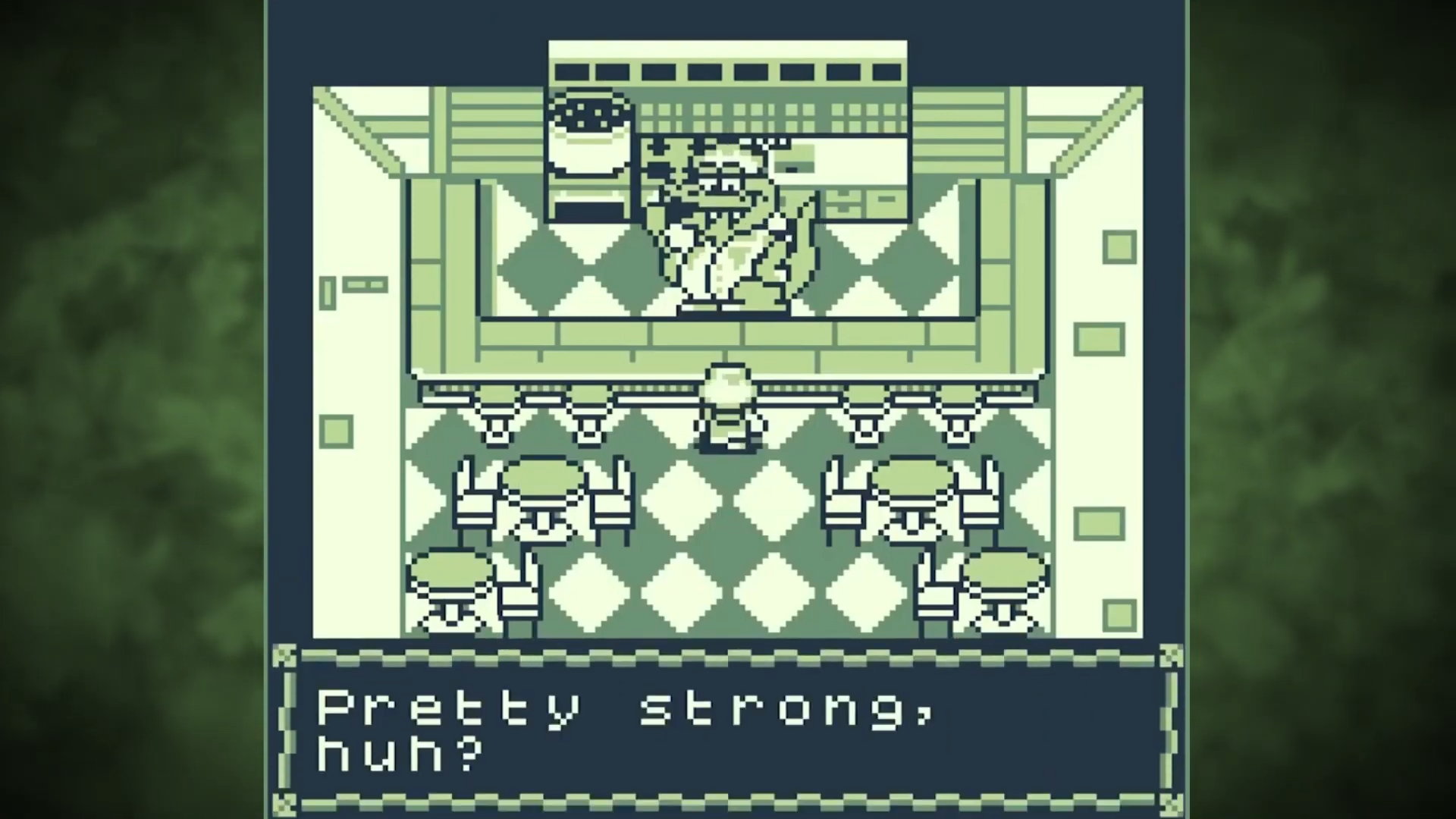The worst-kept secret in all of retro gaming is that most Game Boy games kind of suck. Nintendo’s glorious handheld was one of the most influential, innovative, and successful pieces of hardware in the history of the medium, but if we’re being truly honest, most of its library holds up extremely poorly. The major exceptions—Pokémon Generation 1 and 2, The Legend of Zelda: Link’s Awakening, Kirby’s Dream Land, Tetris—remain excellent games to this day, but nobody out here is really going to bat for Castlevania Legends or the many awful NES and SNES ports of games like Street Fighter II and Mega Man.
Kudzu, the latest indie Zelda-like from Mega Cat Studios and Pie for Breakfast, goes beyond simply evoking basic nostalgia, as the game itself is actually playable on Game Boy via physical cartridge. (I reviewed the game on Nintendo Switch.) Unlike indie hits such as Shovel Knight that aim to mimic the feel of retro titles, Kudzu literally plays like one, with all the shades of green, big text, slow movement, and limited number of potential player inputs. Players seeking something that goes beyond the general vibes of early ’90s handheld gaming will likely see the appeal of Kudzu, with its overhead perspective and easy-to-understand mechanics.
Unfortunately, Kudzu flies a little too close to the sun when trying to capture the essence of yesteryear’s gaming. As a literal Game Boy game built for modern audiences, it successfully captures what that earlier era was like, but in the worst ways. Kudzu doesn’t remind me of Link’s Awakening or Pokemon; it reminds me of shovelware like Buzz Lightyear of Star Command. The game’s undeniable charm (and occasionally clever humor) can’t make up for its clunky gameplay, uninspired world architecture, and boring premise.

Planting the Seeds
In Kudzu, the player inhabits apprentice gardener Max, who goes on an adventure to save his mentor, Zoen, from dangerous kudzu plants that have terrorized the land. Set from a classic Zelda-like top-down view, the game tasks the player with traveling through various theaters of action (taking place in garden-adjacent areas, such as ancient ruins and a haunted house) in an attempt to rescue Zoen.
Mechanically, Kudzu does play somewhat like Link’s Awakening. As the player progresses through the story, they acquire gardening tools that allow them to attack enemies and clear environmental hazards. Every new tool replaces the previous one and grants access to new parts of the map, similar to how Zelda worlds offer new pathways after players find items such as the hookshot or bomb bag. Dungeon areas (such as the aforementioned haunted house) require some very light puzzle-solving, and boss fights test the player’s patience and problem-solving, though they’re not fundamentally that tough. There are even treasure chests containing useful items.

Push and Pull (Mostly Just Pull)
At first, I found Kudzu’s approach to storytelling and basic progression refreshing. You start the game, find out a basic task (give Zoen a cup of tea), and then set off into the world. The story unravels from there, and it becomes clear that this task won’t be so basic.
Unfortunately, once I found the machete (the first garden tool/weapon), everything started to fall apart. To start, the world design is fairly dull. Most environments look similar, making world navigation occasionally confusing (you can buy a map from an NPC in each area, but you ALSO have to buy a compass from the main hub town to know where your character is on that map). While the green shades of the art direction can be delightfully reminiscent of Game Boy greats, the actual enemy and character models leave much to be desired.
Second, most of the puzzle hazards in front of the player are a little too simple: Some dangerous plant consistently shoots a projectile in a single direction over and over, and you have to clear a path so said projectile hits a switch you can’t reach. This process repeats itself over and over, making the overall dungeon experience tedious.
Moreover, the actual combat is equal parts monotonous and frustrating. Once you get the machete, you press the B button (just like any Game Boy action) to swing your weapon at enemies and objects of interest. Unfortunately, it’s not always clear if you actually hit certain enemies (some die, some recoil a bit, others barely react at all), and it’s even less clear whether you get hit yourself, largely due to the incomprehensible absence of sound effects.
Additionally, and this may be somewhat of a nitpick, when you do manage to upgrade your tool (e.g., from a machete to a hoe), the visual representation of that upgrade is nowhere to be seen. Sure, you know you can do more with a hoe than a machete, but all I see is the same swinging animation. I know you can’t really do much with color palettes on the original Game Boy, but couldn’t the game just change the shape of the swing, or its quickness? Anything to make it feel like the fundamental gameplay has improved?

Prickly Problems
The problems don’t just lie in what Max does; there are also myriad issues with what happens to him during combat. When taking damage, a visual cue of a heart appears over Max’s head signifying a loss of health. However, there’s no constant icon on screen to know your current health status; for reasons that completely elude me, you have to pause the game to see what percentage health you have. You can use kudzu jelly to restore health (the jelly itself often appears after killing enemies), but there’s very little to warn the player during actual gameplay that they’re one hit away from death.
Also, in classic retro fashion, Kudzu does not include an autosave feature. The map has a number of save stations scattered throughout, which is a nice touch to an extent, as it forces the player to be mindful of how they’re progressing and creates a layer of friction to an otherwise paint-by-numbers action game. Still, because of the janky combat and lack of modern quality-of-life features, I frequently died in annoying fashion, forcing me to repeat various dungeon segments. In and of itself, repetition in games isn’t inherently bad; in Kudzu, doing the same things over and over again would bother me less if the progression weren’t so linear.
Good throwback design can remind me of why I fell in love with games and makes me want to return to those earlier times, at least in some form. Kudzu, however, does the opposite; playing it makes me yearn for the bloated, boring open worlds of modern games like Horizon Forbidden West and Assassin’s Creed Valhalla. This isn’t Shovel Knight or The Messenger—e.g., a pixelated game that carries the spirit of ’80s/’90s gaming but still mostly feels and plays like modern games. Kudzu seems to believe that the charm of the Game Boy thrives primarily through frustration and needless repetition, not in spite of such things.

Just a Little Sunlight
To be clear, however, Kudzu isn’t all bad. I appreciate the silly characters and plant-based humor. Some of the in-game jokes are genuinely funny: At one point, the player comes across two scientists, one researching plants and the other researching researchers. Other humorous moments come in the form of a merchant claiming that the mushrooms you gave them can help pay off student loans, or another NPC explaining that you can safely turn off your system after saving, but then wondering why they told you that. The story itself isn’t anything special, but the writing itself has its moments.
Also, if you’re playing on Switch, the wider screen comes with black borders that can easily be swapped out for more exciting ones. For example, you can have the sides mimic the game cover (the way a classic arcade machine would) or a wood-panel CRT television. Publishers Mega Cat and 8bit-Legit clearly have an appreciation for the aesthetics surrounding retro games as much as the games themselves, and as The Punished Backlog’s resident Old Games Guy, I admire that attention to detail.

Final Thoughts
Ultimately, Kudzu’s reliance on charm and nostalgia fails to conceal its greater failings. Attempting to bring back the gameplay and broader stylings of classic titles can be a tall task, but we can’t lower our standards the way we may have during the actual Game Boy era. Kudzu serves as an uncomfortable reminder that maybe some things deserve to stay in the past.
Score: 4.0/10
Kudzu is out now for Nintendo Switch and Game Boy. The Switch version retails for $4.99, while the Game Boy version can be purchased from Mega Cat Studios’ website starting at $39.99.
Disclaimer: A review code was provided by the publisher.
Sam has been playing video games since his earliest years and has been writing about them since 2016. He’s a big fan of Nintendo games and complaining about The Last of Us Part II. You either agree wholeheartedly with his opinions or despise them. There is no in between.
A lifelong New Yorker, Sam views gaming as far more than a silly little pastime, and hopes though critical analysis and in-depth reviews to better understand the medium's artistic merit.
Twitter: @sam_martinelli.








